Death of Adolf Hitler
Adolf Hitler was an Austrian-German politician who was the leader of the Nazi Party, Chancellor of Germany from 1933 to 1945, and Führer ('Leader') of Nazi Germany from 1934 to 1945. He killed himself by gunshot on 30 April 1945 in his Führerbunker in Berlin.[lower-alpha 1][lower-alpha 2][lower-alpha 3] Eva Braun, his wife of one day, committed suicide with Hitler by taking cyanide.[lower-alpha 4] In accordance with his prior written and verbal instructions, that afternoon their remains were carried up the stairs through the bunker's emergency exit, doused in petrol, and set alight in the Reich Chancellery garden outside the bunker.[1][2] Records in the Soviet archives show that their burned remains were recovered and interred in successive locations until 1946.[lower-alpha 5] They were exhumed again and cremated in 1970, and the ashes were scattered.[lower-alpha 6]

Accounts differ as to Hitler's cause of death; one version states that he died by poison only[lower-alpha 7] and another view claims that he died by a self-inflicted gunshot while biting down on a cyanide capsule.[lower-alpha 8] Contemporary historians have rejected these accounts as being either Soviet propaganda[lower-alpha 9][lower-alpha 10] or an attempted compromise in order to reconcile the different conclusions.[lower-alpha 8][lower-alpha 11] One eyewitness stated that Hitler's corpse showed signs of having been shot through the mouth, but this has been proven unlikely.[lower-alpha 12][lower-alpha 13] Dental remains found on Hitler's corpse were matched with his dental records in 1945.[3][lower-alpha 14]
For political reasons, the Soviet Union presented various versions of Hitler's fate.[4][5] They maintained in the years immediately following the war that Hitler was not dead, but had fled and was being shielded by the former Western Allies.[4]
Preceding events
By early 1945, Nazi Germany was on the verge of total military collapse. Poland had fallen to the advancing Soviet Red Army, which was preparing to cross the Oder between Küstrin and Frankfurt with the objective of capturing Berlin 82 kilometres (51 mi) to the west.[6] German forces had recently lost to the Allies in the Ardennes Offensive, with British and Canadian forces crossing the Rhine into the German industrial heartland of the Ruhr.[7] U.S. forces in the south had captured Lorraine and were advancing towards Mainz, Mannheim, and the Rhine.[7] German forces in Italy were withdrawing north, as they were pressed by the U.S. and Commonwealth forces as part of the Spring Offensive to advance across the Po and into the foothills of the Alps.[8]
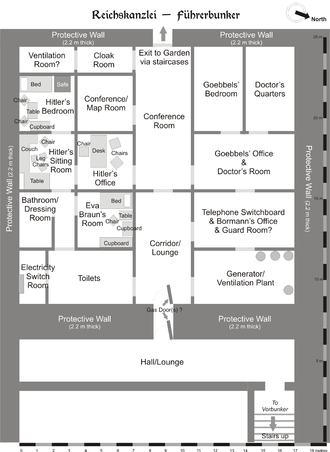
Hitler retreated to his Führerbunker in Berlin, on 16 January 1945. It was clear to the Nazi leadership that the battle for Berlin would be the final battle of the war in Europe.[9] Some 325,000 soldiers of Germany's Army Group B were surrounded and captured on 18 April, leaving the path open for U.S. forces to reach Berlin. By 11 April the Americans crossed the Elbe, 100 kilometres (62 mi) to the west of the city.[10] On 16 April, Soviet forces to the east crossed the Oder and commenced the battle for the Seelow Heights, the last major defensive line protecting Berlin on that side.[11] By 19 April, the Germans were in full retreat from Seelow Heights, leaving no front line. Berlin was bombarded by Soviet artillery for the first time on 20 April, which was also Hitler's birthday. By the evening of 21 April, Red Army tanks reached the outskirts of the city.[12]
At the afternoon situation conference on 22 April, Hitler suffered a total nervous collapse when he was informed that the orders he had issued the previous day for SS-General Felix Steiner's Army Detachment Steiner to counterattack had not been obeyed.[13] Hitler launched a tirade against his commanders, calling them treacherous and incompetent, culminating in a declaration—for the first time—that the war was lost. Hitler announced that he would stay in Berlin until the end and then shoot himself.[14] Later that day, he asked SS physician Werner Haase about the most reliable method of suicide. Haase suggested the "pistol-and-poison method" of combining a dose of cyanide with a gunshot to the head.[15] Luftwaffe chief Reichsmarschall Hermann Göring learned about this and sent a telegram to Hitler asking for permission to take over the leadership of the Reich in accordance with Hitler's 1941 decree naming him as his successor.[16] Hitler's secretary Martin Bormann convinced Hitler that Göring was threatening a coup.[17] In response, Hitler informed Göring that he would be executed unless he resigned all of his posts. Later that day, he sacked Göring from all of his offices and ordered his arrest.[18]
By 27 April, Berlin was cut off from the rest of Germany. Secure radio communications with defending units had been lost; the command staff in the Führerbunker had to depend on telephone lines for passing instructions and orders, and on public radio for news and information.[19] On 28 April, Hitler received a BBC report originating from Reuters; the report stated that Reichsführer-SS Heinrich Himmler had offered to surrender to the Western Allies. The offer was declined. Himmler had implied to the Allies that he had the authority to negotiate a surrender, which Hitler considered to be treason. That afternoon, Hitler's anger and bitterness escalated into a rage against Himmler.[20] Hitler ordered Himmler's arrest and had Hermann Fegelein (Himmler's SS representative at Hitler's headquarters) shot for desertion.[21]
By this time, the Red Army had advanced to the Potsdamer Platz, and all indications were that they were preparing to storm the Chancellery. This report and Himmler's treachery prompted Hitler to make the last decisions of his life.[22] Shortly after midnight on 29 April,[23][24] he married Eva Braun in a small civil ceremony in a map room within the Führerbunker. Hitler then hosted a modest wedding breakfast with his new wife, after which he took secretary Traudl Junge to another room and dictated his last will and testament. It left instructions to be carried out immediately following his death, with Grand Admiral Karl Dönitz and Joseph Goebbels assuming Hitler's roles as head of state and chancellor respectively.[25] Hitler signed these documents at 04:00 and then went to bed. Some sources say that he dictated the last will and testament immediately before the wedding, but all agree on the timing of the signing.[lower-alpha 15][lower-alpha 16]
On the afternoon of 29 April, Hitler learned that his ally, Benito Mussolini, had been executed by Italian partisans. The bodies of Mussolini and his mistress, Clara Petacci, had been strung up by their heels. The corpses were later cut down and thrown into the gutter, where they were mocked by Italian dissenters. These events may have strengthened Hitler's resolve not to allow himself or his wife to be made a "spectacle" of, as he had earlier recorded in his testament.[26][lower-alpha 17] Doubting the efficacy of the cyanide capsules distributed by SS physician Dr. Ludwig Stumpfegger, Hitler ordered Dr. Haase to test one on his dog Blondi, who died as a result.[27]
Suicide
Hitler and Braun lived together as husband and wife in the bunker for less than forty hours. By 01:00 on 30 April, Field Marshall Wilhelm Keitel had reported that all of the forces on which Hitler had been depending to rescue Berlin had either been encircled or forced onto the defensive.[28] At around 02:30, Hitler appeared in the corridor where about twenty people, mostly women, were assembled to give their farewells. He walked the line and shook hands with each of them before retiring to his quarters.[29] Late in the morning, with the Soviets less than 500 metres (1,600 ft) from the Führerbunker, Hitler had a meeting with General Helmuth Weidling, the commander of the Berlin Defence Area. Weidling told Hitler that the garrison would probably run out of ammunition that night, and that the fighting in Berlin would inevitably come to an end within the next 24 hours.[28] Weidling asked for permission for a break-out; this was a request he had unsuccessfully made before. Hitler did not answer, and Weidling went back to his headquarters in the Bendlerblock. At about 13:00 he received Hitler's permission to try a break-out that night.[30] Hitler, two secretaries, and his personal cook then had lunch, after which Hitler and Braun said goodbye to members of the bunker staff and fellow occupants, including Bormann, Goebbels and his family, the secretaries, and several military officers. At around 14:30 Adolf and Eva Hitler went into his personal study.[30]
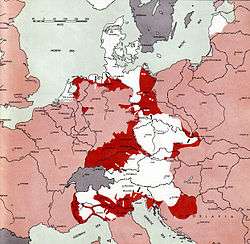
Several witnesses later reported that they heard a loud gunshot at approximately 15:30. After waiting a few minutes, Hitler's valet, Heinz Linge, opened the study door with Bormann at his side.[31] Linge later stated that he immediately noted a scent of burnt almonds, which is a common observation in the presence of prussic acid (hydrogen cyanide).[31] Hitler's adjutant, SS-Sturmbannführer Otto Günsche, entered the study and found the two lifeless bodies on the sofa. Eva, with her legs drawn up, was to Hitler's left and slumped away from him. Günsche stated that Hitler "sat ... sunken over, with blood dripping out of his right temple. He had shot himself with his own pistol, a Walther PPK 7.65."[32][31][33] The gun lay at his feet[31] and according to SS-Oberscharführer Rochus Misch, Hitler's head was lying on the table in front of him.[34] Blood dripping from Hitler's right temple and chin had made a large stain on the right arm of the sofa and was pooling on the carpet. According to Linge, Eva's body had no visible physical wounds, and her face showed how she had died—by cyanide poisoning.[lower-alpha 18] Günsche and SS-Brigadeführer Wilhelm Mohnke stated "unequivocally" that all outsiders and those performing duties and work in the bunker "did not have any access" to Hitler's private living quarters during the time of death (between 15:00 and 16:00).[35]
Günsche left the study and announced that Hitler was dead.[36] In accordance with Hitler's prior written and verbal instructions, the two bodies were carried up the stairs and through the bunker's emergency exit to the garden behind the Reich Chancellery, where they were to be burned with petrol.[1][2] Misch reported Hitler's death to Franz Schädle and returned to the telephone switchboard, later recalling someone shouting that Hitler's body was being burned.[34][37] After the first attempts to ignite the petrol did not work, Linge went back inside the bunker and returned with a thick roll of papers. Bormann lit the papers and threw them onto the bodies. As the two corpses caught fire, a group including Bormann, Günsche, Linge, Goebbels, Erich Kempka, Peter Högl, Ewald Lindloff, and Hans Reisser raised their arms in salute as they stood just inside the bunker doorway.[38][39]
At around 16:15, Linge ordered SS-Untersturmführer Heinz Krüger and SS-Oberscharführer Werner Schwiedel to roll up the rug in Hitler's study to burn it. Schwiedel later stated that upon entering the study, he saw a pool of blood the size of a "large dinner plate" by the arm-rest of the sofa. Noticing a spent cartridge case, he bent down and picked it up from where it lay on the rug about 1 mm from a 7.65 pistol.[40] The two men removed the blood-stained rug and carried it up the stairs and outside to the Chancellery garden, where it was placed on the ground and burned.[41]
The Red Army shelled the area in and around the Reich Chancellery on and off during the afternoon. SS guards brought over additional cans of petrol to further burn the corpses. Linge later noted the fire did not completely destroy the remains, as the corpses were being burned in the open, where the distribution of heat varies.[42] The corpses burned from 16:00 to 18:30.[43] At approximately 18:30, Lindloff and Reisser covered up the remains in a shallow bomb crater.[44]
Aftermath
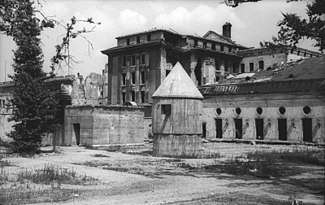

The first inkling to the outside world that Hitler was dead came from the Germans themselves. On 1 May, the Reichssender Hamburg radio station interrupted their normal program to announce that Hitler had died that afternoon,[lower-alpha 19] and introduced his successor, President Karl Dönitz.[45] Dönitz called upon the German people to mourn their Führer, who he stated had died a hero defending the capital of the Reich.[46][47] Hoping to save the army and the nation by negotiating a partial surrender to the British and Americans, Dönitz authorised a fighting withdrawal to the west. His tactic was somewhat successful: it enabled about 1.8 million German soldiers to avoid capture by the Soviets, but it came at a high cost in bloodshed, as troops continued to fight until 8 May.[48]
General Hans Krebs met Soviet General Vasily Chuikov just prior to 04:00 on 1 May, giving him the news of Hitler's death, while attempting to negotiate a ceasefire and open "peace negotiations".[49][50] Joseph Stalin was informed of Hitler's suicide around 04:05 Berlin time, thirteen hours after the event.[51][52] He demanded unconditional surrender, which Krebs lacked authorisation to give.[53][54] Stalin wanted confirmation that Hitler was dead and ordered the Red Army's SMERSH unit to find the corpse.[55] In the early morning hours of 2 May, the Soviets captured the Reich Chancellery.[56] Inside the Führerbunker, General Krebs and General Wilhelm Burgdorf committed suicide by gunshot to the head.[57]
On 4 May, the thoroughly burned remains of Hitler, Braun, and two dogs (thought to be Blondi and her offspring, Wulf) were discovered in a shell crater by SMERSH commander Ivan Klimenko.[58][59] They were exhumed the next day and secretly delivered to the SMERSH Counter-Espionage Section of the 3rd Assault Army in Buch.[60] Stalin was wary of believing Hitler was dead, and restricted the release of information to the public.[61][62] By 11 May, part of a lower jaw with dental work was identified as Hitler's; his dentist's assistant Käthe Heusermann and dental technician Fritz Echtmann both confirmed dental remains of Hitler and Braun.[63][64][lower-alpha 14] Details of the Soviet autopsy were made public in 1968 and used by odontologists at the University of California, Los Angeles (UCLA) to confirm the remains as Hitler's in 1972.[65][lower-alpha 20]
In early June 1945, the bodies of Hitler, Braun, Joseph and Magda Goebbels, the six Goebbels children, Krebs, Blondi and another dog were moved from Buch to Finow, where the SS guard who buried Hitler reidentified his remains.[66][lower-alpha 21] The bodies were reburied in a forest in Brandenburg on 3 June, and finally exhumed and moved to the SMERSH unit's new facility in Magdeburg, where they were buried in five wooden boxes on 21 February 1946.[63][67][68][69] By 1970, the facility was under the control of the KGB and scheduled to be relinquished to East Germany. Concerned that a known Hitler burial site might become a neo-Nazi shrine, KGB director Yuri Andropov authorised an operation to destroy the remains that were buried there in 1946.[70] A KGB team was given detailed burial charts and on 4 April 1970 secretly exhumed the remains of ten or eleven bodies "in an advanced state of decay". The remains were thoroughly burned and crushed, and the ashes thrown into the Biederitz river, a tributary of the nearby Elbe.[71][lower-alpha 22]
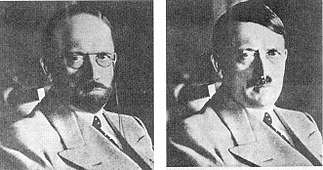
For politically motivated reasons, the Soviet Union presented various versions of Hitler's fate.[4][5] When asked in July 1945 how Hitler had died, Stalin said he was living "in Spain or Argentina".[72] In November 1945, Dick White, the head of counter-intelligence in the British sector of Berlin, had their agent Hugh Trevor-Roper investigate the matter to counter the Soviet claims. His report was published in 1947 as The Last Days of Hitler.[73] In the years immediately after the war, the Soviets maintained that Hitler was not dead, but had escaped and was being shielded by the former Western Allies.[4]
On 30 May 1946, MVD agents recovered two fragments of a skull from the crater where Hitler was buried. The left parietal bone had gunshot damage.[74] This piece remained uncatalogued until 1975,[75] and was rediscovered in the Russian State Archives in 1993.[76] In 2009, DNA and forensic tests were performed on a small piece detached from the skull fragment,[77] which Soviet officials had long believed to be Hitler's. According to the U.S. researchers, their tests revealed that it actually belonged to a woman and the examination of the skull sutures placed her at less than 40 years old.[78][79][lower-alpha 23]
Throughout the late 1940s and 1950s, the FBI and CIA documented many possible leads that Hitler might still be alive, while lending none of them credence.[80] The documents were declassified under the Nazi War Crimes Disclosure Act, and began to be released online by the early 2010s.[81][82] The secrecy in which the investigation was shrouded has inspired numerous conspiracy theories.[83]
On 29 December 1949, a secret dossier was presented to Stalin, which was based upon the thorough questioning of Nazis who had been present in the Führerbunker, including Günsche and Linge.[84] Western historians were allowed into the archives of the former Soviet Union beginning in 1991, but the dossier remained undiscovered for twelve years; in 2005 it was published as The Hitler Book.[84]
In 1968, Soviet journalist Lev Bezymenski published his book including details of Hitler's autopsy.[65] The purported Soviet forensic examination led by Faust Shkaravsky concluded that he had died by cyanide poisoning, while Bezymenski theorizes that Hitler requested a coup de grâce to ensure his quick death.[85] Bezymenski later admitted that his work included "deliberate lies", such as the manner of Hitler's death.[4]
Gallery
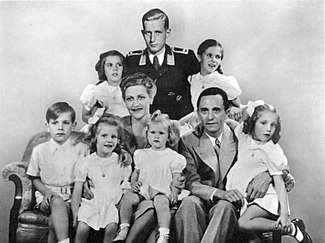 Joseph Goebbels, his wife Magda, and their six children. In the back is Goebbels' stepson, Harald Quandt, the sole family member to survive the war.
Joseph Goebbels, his wife Magda, and their six children. In the back is Goebbels' stepson, Harald Quandt, the sole family member to survive the war. Hitler (right) visiting Berlin defenders in early April 1945 with Hermann Göring (centre) and the Chief of the OKW Field Marshal Keitel (partially hidden)
Hitler (right) visiting Berlin defenders in early April 1945 with Hermann Göring (centre) and the Chief of the OKW Field Marshal Keitel (partially hidden)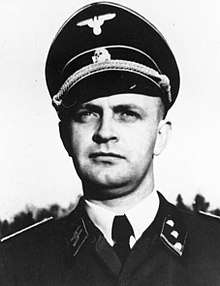 Heinz Linge, Hitler's valet, was one of the first people into Hitler's study after the suicide.
Heinz Linge, Hitler's valet, was one of the first people into Hitler's study after the suicide. Churchill sits on a damaged chair from the Führerbunker in July 1945.
Churchill sits on a damaged chair from the Führerbunker in July 1945.
See also
- The Bunker (1981 film)
- The Bunker (book)
- "The Death of Adolf Hitler" (Sunday Night Theatre episode)
- Downfall (2004 film)
- Führer Headquarters
- Glossary of Nazi Germany
- Hitler: The Last Ten Days (1973 film)
- List of Nazi Party leaders and officials
- Popular culture representations of Hitler after his death
- Vorbunker
- War and Remembrance (TV miniseries)
References
Informational notes
- "... Günsche stated he entered the study to inspect the bodies, and observed Hitler ... sat ... sunken over, with blood dripping out of his right temple. He had shot himself with his own pistol, a PPK 7.65." (Fischer 2008, p. 47).
- "... blood dripped from a bullet hole in his right temple ..." (Kershaw 2008, p. 955).
- "... 30 April ... During the afternoon Hitler shot himself..." (MI5 staff 2011).
- "... her lips puckered from the poison." (Beevor 2002, p. 359).
- "... [the bodies] were deposited ... in an unmarked grave in a forest far to the west of Berlin, reburied in 1946 in a plot of land in Magdeburg." (Kershaw 2008, p. 958).
- "In 1970, the Kremlin finally decided to dispose of the body in absolute secrecy... the body, which had been concealed beneath a Soviet army parade-ground in Magdeburg, was exhumed at night and burned." (Beevor 2002, p. 431).
- "... both committing suicide by biting their cyanide ampoules." (Erickson 1983, p. 606).
- "... we have a fair answer ... to the version of ... Russian author Lev Bezymenski ... Hitler did shoot himself and did bite into the cyanide capsule, just as Professor Haase had clearly and repeatedly instructed ... " (O'Donnell 2001, pp. 322–323).
- "New versions of Hitler's fate were presented by the Soviet Union according to the political needs of the moment." (Eberle & Uhl 2005, p. 288).
- "The intentionally misleading account of Hitler's death by cyanide poisoning put about by Soviet historians ... can be dismissed." (Kershaw 2001, p. 1037).
- "... most Soviet accounts have held that Hitler also [Hitler and Eva Braun] ended his life by poison ... there are contradictions in the Soviet story ... these contradictions tend to indicate that the Soviet version of Hitler's suicide has a political colouration." (Fest 1974, p. 749).
- "Axmann elaborated on his testimony when questioned about his "assumption" that Hitler had shot himself through the mouth."(Joachimsthaler 1999, p. 157).
- "... the version involving a 'shot in the mouth' with secondary injuries to the temples must be rejected ... the majority of witnesses saw an entry wound in the temple.. according to all witnesses there was no injury to the back of the head." (Joachimsthaler 1999, p. 166).
- "... the only thing to remain of Hitler was a gold bridge with porcelain facets from his upper jaw and the lower jawbone with some teeth and two bridges." (Joachimsthaler 1999, p. 225).
- Using sources available to Trevor-Roper (a World War II MI5 agent and historian/author of The Last Days of Hitler), MI5 records the marriage as taking place after Hitler had dictated the last will and testament. (MI5 staff 2011).
- Beevor 2002, p. 343 records the marriage as taking place before Hitler had dictated the last will and testament.
- It is unknown how much of this was communicated to Hitler. (Shirer 1960, p. 1131).
- "Cyanide poisoning. Its 'bite' was marked in her features." (Linge 2009, p. 199).
- Hitler had actually died the previous day. (Shirer 1960, p. 1137).
- In 2017, French forensic pathologist Philippe Charlier also found teeth on a jawbone fragment to be in "perfect agreement" with an X-ray taken of Hitler in 1944. (Brisard & Parshina 2018, pp. 224, 273–274).
- "... the facial structure remained clearly identifiable. There was a bullethole in one temple, but the upper and lower jaw were both intact." (Trevor-Roper 1992, p. 34).
- Beevor states that "... the ashes were flushed into the town [Magdeburg] sewage system." (Beevor 2002, p. 431).
- Charlier stated, "When doing a diagnostic of the skull, you have a 55 per cent chance of getting the sex right." (Lusher 2018).
Citations
- Kershaw 2008, pp. 954, 956.
- Linge 2009, pp. 199, 200.
- Lusher 2018.
- Eberle & Uhl 2005, p. 288.
- Kershaw 2001, p. 1037.
- Horrabin 1946, Vol. X, p. 51.
- Horrabin 1946, Vol. X, p. 53.
- Horrabin 1946, Vol. X, p. 43.
- Beevor 2002, p. 139.
- Shirer 1960, p. 1105.
- Beevor 2002, pp. 209–217.
- Beevor 2002, pp. 255–256, 262.
- Erickson 1983, p. 586.
- Beevor 2002, p. 275.
- O'Donnell 2001, pp. 230, 323.
- Shirer 1960, p. 1116.
- Beevor 2002, p. 289.
- Shirer 1960, p. 1118.
- Beevor 2002, p. 323.
- Kershaw 2008, pp. 943–946.
- Kershaw 2008, pp. 946–947.
- Shirer 1960, p. 1194.
- Kershaw 2001, p. 821.
- Joachimsthaler 1999, p. 278.
- Kershaw 2008, pp. 949–950.
- Shirer 1960, p. 1131.
- Kershaw 2008, pp. 951–952.
- Erickson 1983, pp. 603–604.
- Shirer 1960, p. 1132.
- Beevor 2002, p. 358.
- Linge 2009, p. 199.
- Fischer 2008, p. 47.
- Joachimsthaler 1999, pp. 160–182.
- Rosenberg 2009.
- Fischer 2008, pp. 47–48.
- Joachimsthaler 1999, p. 156.
- Misch 2014, p. 173.
- Linge 2009, p. 200.
- Joachimsthaler 1999, pp. 197, 198.
- Joachimsthaler 1999, p. 162.
- Joachimsthaler 1999, pp. 162, 175.
- Joachimsthaler 1999, pp. 210–211.
- Joachimsthaler 1999, p. 211.
- Joachimsthaler 1999, pp. 217–220.
- Shirer 1960, p. 1137.
- Beevor 2002, p. 381.
- Kershaw 2008, p. 959.
- Kershaw 2008, pp. 961–963.
- Beevor 2002, pp. 367–368.
- Eberle & Uhl 2005, pp. 280, 281.
- Beevor 2002, p. 368.
- Eberle & Uhl 2005, p. 280.
- Ryan 1994, p. 364.
- Misch 2014, p. 175.
- Eberle & Uhl 2005, p. 281.
- Beevor 2002, pp. 387, 388.
- Beevor 2002, p. 387.
- Erickson 1983, p. 435.
- Petrova & Watson 1995, p. xi.
- Vinogradov et al. 2005, p. 110.
- Kershaw 2001, pp. 1038, 1039.
- Dolezal 2004, pp. 185–186.
- Kershaw 2008, p. 958.
- Eberle & Uhl 2005, p. 282.
- Senn & Weems 2013, p. 43.
- Trevor-Roper 1992, pp. 31, 34.
- Vinogradov et al. 2005, pp. 111–116.
- Halpin & Boyes 2009.
- Tkachenko 2009.
- Vinogradov et al. 2005, p. 333.
- Vinogradov et al. 2005, pp. 335–336.
- Beschloss 2002.
- MI5 staff 2011.
- Eberle & Uhl 2005, pp. 287, 288.
- Brisard & Parshina 2018, pp. 29, 30, 32.
- Isachenkov 1993.
- Brisard & Parshina 2018, pp. 18–22.
- Goñi 2009.
- CNN staff 2009.
- CIA Chief of Station, Caracas 1955.
- CIA staff 2013.
- FBI Records 2011.
- Anderson 2015.
- Eberle & Uhl 2005, p. xxvi.
- Bezymenski 1968, pp. 49, 75.
Bibliography
- Anderson, John (10 November 2015). "One Industry That Capitalizes on America's Hitler Fascination". Fortune. Retrieved 19 September 2018.CS1 maint: ref=harv (link)
- Beevor, Antony (2002). Berlin – The Downfall 1945. New York: Viking-Penguin. ISBN 978-0-670-03041-5.CS1 maint: ref=harv (link)
- Beschloss, Michael (December 2002). "Dividing the Spoils". Smithsonian Magazine. Retrieved 5 September 2018.CS1 maint: ref=harv (link)
- Bezymenski, Lev (1968). The Death of Adolf Hitler (1st ed.). New York: Harcourt, Brace & World.CS1 maint: ref=harv (link)
- Brisard, Jean-Christophe; Parshina, Lana (2018). The Death of Hitler. Da Capo Press. ISBN 978-0306922589.CS1 maint: ref=harv (link)
- CIA Chief of Station, Caracas (3 October 1955), HVCA-2592 (PDF), CIA, retrieved 6 September 2018CS1 maint: ref=harv (link)
- CIA staff (2013), Advanced Search: Nazi War Crimes Disclosure Act, CIA FOIA, archived from the original on 8 January 2019, retrieved 17 July 2019CS1 maint: ref=harv (link)
- CNN staff (11 December 2009). "Russians insist skull fragment is Hitler's". CNN. Retrieved 1 October 2013.CS1 maint: ref=harv (link)
- Dolezal, Robert (2004). Truth about History: How New Evidence Is Transforming the Story of the Past. Pleasantville, NY: Readers Digest. pp. 185–6. ISBN 0-7621-0523-2.CS1 maint: ref=harv (link)
- Eberle, Henrik; Uhl, Matthias, eds. (2005). The Hitler Book: The Secret Dossier Prepared for Stalin from the Interrogations of Hitler's Personal Aides. New York: Public Affairs. ISBN 978-1-58648-366-1.CS1 maint: ref=harv (link)
- Erickson, John (1983). The Road to Berlin: Stalin's War with Germany: Volume 2. London: Weidenfeld and Nicolson. ISBN 978-0-297-77238-5.CS1 maint: ref=harv (link)
- Fest, Joachim C. (1974). Hitler. New York: Harcourt. ISBN 978-0-15-141650-9.CS1 maint: ref=harv (link)
- Fischer, Thomas (2008). Soldiers of the Leibstandarte. Winnipeg: J.J. Fedorowicz. ISBN 978-0-921991-91-5.CS1 maint: ref=harv (link)
- Goñi, Uki (27 September 2009). "Tests on skull fragment cast doubt on Adolf Hitler suicide story". The Guardian. London. Retrieved 1 October 2013.CS1 maint: ref=harv (link)
- Halpin, Tony; Boyes, Roger (9 December 2009). "Battle of Hitler's skull prompts Russia to reveal all". The Times. Archived from the original on 29 June 2011. Retrieved 1 October 2013.CS1 maint: ref=harv (link)
- Horrabin, J.F. (1946). Vol. X: May 1944 – August 1945. An Atlas-History of the Second Great War. Edinburgh: Thomas Nelson & Sons. OCLC 464378076.
- Isachenkov, Vladimir (20 February 1993). "Russians say they have bones from Hitler's skull". Gadsen Times. Associated Press. Retrieved 11 January 2015.CS1 maint: ref=harv (link)
- Joachimsthaler, Anton (1999) [1995]. The Last Days of Hitler: The Legends, The Evidence, The Truth. London: Brockhampton Press. ISBN 978-1-86019-902-8.CS1 maint: ref=harv (link)
- Kershaw, Ian (2001) [2000]. Hitler, 1936–1945: Nemesis. London: Penguin. ISBN 978-0-14-027239-0.CS1 maint: ref=harv (link)
- Kershaw, Ian (2008). Hitler: A Biography. New York: W. W. Norton & Company. ISBN 978-0-393-06757-6.CS1 maint: ref=harv (link)
- Linge, Heinz (2009). With Hitler to the End. Frontline Books–Skyhorse Publishing. ISBN 978-1-60239-804-7.CS1 maint: ref=harv (link)
- Lusher, Adam (20 May 2018). "Adolf Hitler really is dead: scientific study debunks conspiracy theories that he escaped to South America". Independent. Retrieved 25 September 2018.CS1 maint: ref=harv (link)
- MI5 staff (2011). "Hitler's last days". Her Majesty's Security Service website. Retrieved 1 October 2013.CS1 maint: ref=harv (link)
- Misch, Rochus (2014) [2008]. Hitler's Last Witness: The Memoirs of Hitler's Bodyguard. London: Frontline Books-Skyhorse Publishing, Inc. ISBN 978-1-848-32749-8.CS1 maint: ref=harv (link)
- O'Donnell, James P. (2001) [1978]. The Bunker. New York: Da Capo Press. ISBN 978-0-306-80958-3.CS1 maint: ref=harv (link)
- Petrova, Ada; Watson, Peter (1995). The Death of Hitler: The Full Story with New Evidence from Secret Russian Archives. W.W. Norton & Company. ISBN 978-0-393-03914-6.CS1 maint: ref=harv (link)
- Senn, David R.; Weems, Richard A. (2013). Manual of Forensic Odontology. Boca Raton: CRC Press. ISBN 978-1-439-85134-0.CS1 maint: ref=harv (link)
- Shirer, William L. (1960). The Rise and Fall of the Third Reich. New York: Simon & Schuster. ISBN 978-0-671-62420-0.CS1 maint: ref=harv (link)
- Rosenberg, Steven (3 September 2009). "I was in Hitler's suicide bunker". BBC News. Retrieved 1 October 2013.CS1 maint: ref=harv (link)
- Ryan, Cornelius (1994) [1966]. The Last Battle. New York: Simon & Schuster. ISBN 978-1-439-12701-8.CS1 maint: ref=harv (link)
- Trevor-Roper, Hugh (1992) [1947]. The Last Days of Hitler. Chicago: University of Chicago Press. ISBN 978-0-226-81224-3.CS1 maint: ref=harv (link)
- Tkachenko, Maxim (11 December 2009). "Official: KGB chief ordered Hitler's remains destroyed". CNN.CS1 maint: ref=harv (link)
- Vinogradov, V. K.; Pogonyi, J.F.; Teptzov, N.V. (2005). Hitler's Death: Russia's Last Great Secret from the Files of the KGB. London: Chaucer Press. ISBN 978-1-904449-13-3.
- US Federal Bureau of Investigation (10 April 2011). "Adolf Hitler". FBI Records: The Vault. Retrieved 8 January 2019.
Further reading
Books
- Bullock, Alan (1962). Hitler: A Study in Tyranny. New York: Penguin Books. ISBN 978-0-14-013564-0.
- Daly-Groves, Luke (2019). Hitler's Death: The Case Against Conspiracy. Oxford, UK: Osprey. ISBN 978-1-4728-3454-6.
- Fest, Joachim (2004). Inside Hitler's Bunker: The Last Days of the Third Reich. New York: Farrar, Straus and Giroux. ISBN 978-0-374-13577-5.
- Galante, Pierre; Silianoff, Eugene (1989). Voices From the Bunker. New York: G. P. Putnam's Sons. ISBN 978-0-3991-3404-3.
- Gardner, Dave (2001). The Last of the Hitlers: The story of Adolf Hitler's British Nephew and the Amazing Pact to Make Sure his Genes Die Out. Worcester, UK: BMM. ISBN 978-0-9541544-0-0.
- Lehmann, Armin D. (2004). In Hitler's Bunker: A Boy Soldier's Eyewitness Account of the Führer's Last Days. Guilford, CT: Lyon's Press. ISBN 978-1-59228-578-5.
- Rzhevskaya, Elena (1965). Берлин, май 1945. Записки военного переводчика [Berlin 1945: Memoirs of a Wartime Interpreter].
- Waite, Robert G. L. (1993) [1977]. The Psychopathic God: Adolf Hitler. New York: DaCapo Press. ISBN 978-0-306-80514-1.
Articles
- BBC staff (26 April 2000). "Russia displays 'Hitler skull fragment'". BBC.
- Daley, Jason (22 May 2018). "Hitler's Teeth Confirm He Died in 1945". Smithsonian.
- Marchetti, Daniela, M.D., PhD; Boschi, Ilaria, PhD; Polacco, Matteo, M.D.; Rainio, Juha, M.D., PhD (2005). "The Death of Adolf Hitler—Forensic Aspects". Journal of Forensic Sciences. 50 (5). JFS2004314.
- Petrova, Ada; Watson, Peter (1995). "The Death of Hitler: The Full Story with New Evidence from Secret Russian Archives". The Washington Post.
- Sognnaes, Reidar F.; Ström, Ferdinand (1973). "The odontological identification of Adolf Hitler". Acta Odontologica Scandinavica. 31 (1): 47. doi:10.3109/00016357309004612. PMID 4575430.
